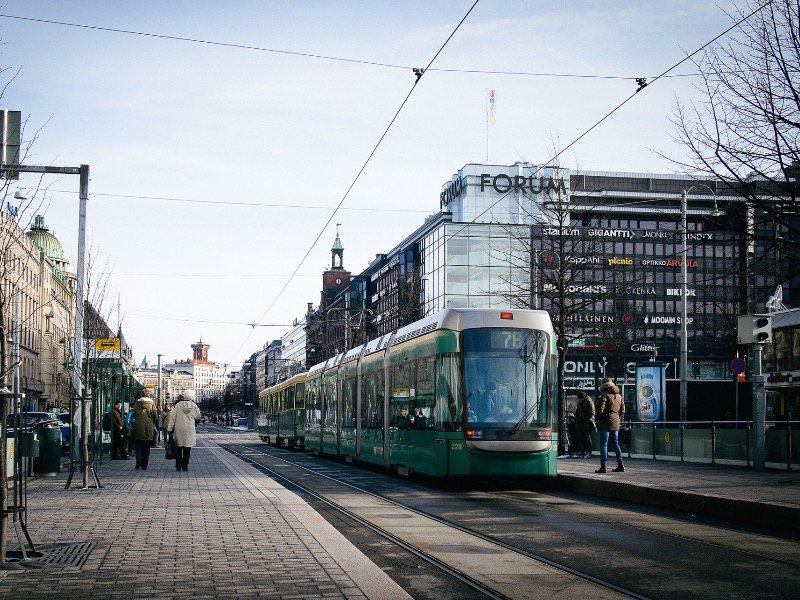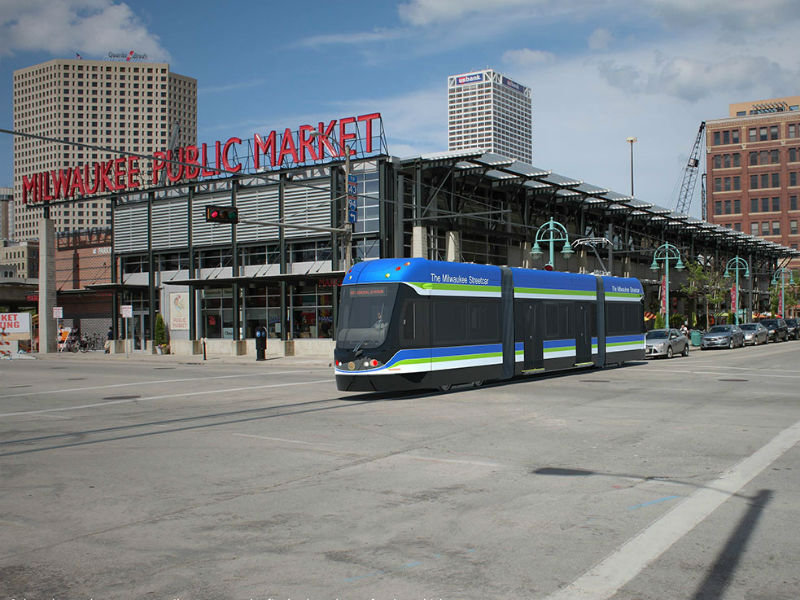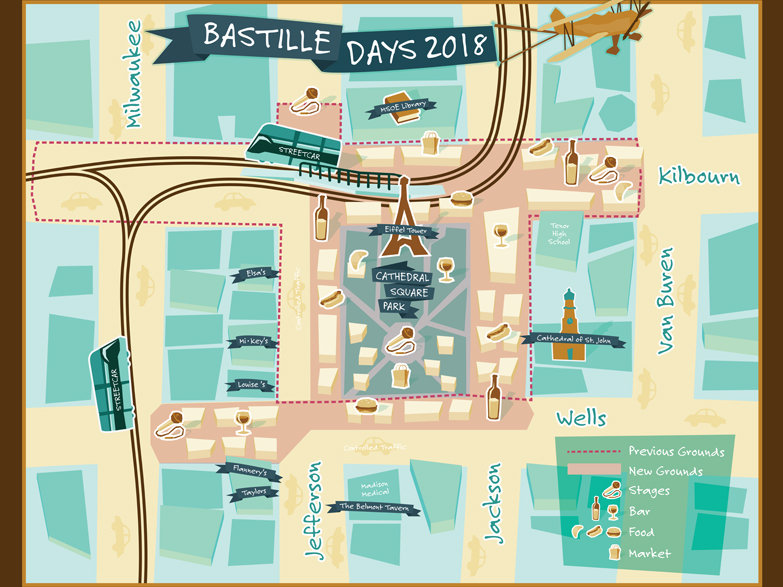"This really is returning the connector study to its roots and to its original intent and that is to build a relatively short, inexpensive Downtown oriented fixed guideway transportation system," Bauman said.
The proposed system, which carries a price tag in the range of $30-40 million and could be completed in about two years -- would run in a 3-mile circle along East St. Paul Avenue, North 4th Street, East Juneau Avenue, North Jackson Street and North Van Buren Street. A short lakefront section would serve Maier Festival Park in summer.
Future extensions of the system could link Walker's Point, Brady Street, Bronzeville, The Pabst complex and Potawatomi Bingo Casino in the Menomonee Valley.
"This idea builds on the foundation of the original Milwaukee Connector study," said Department of City Develpment Commissioner Rocky Marcoux. "It circulates people to major tourist attractions and gets commuters to transportation connections both in and out of the city. I believe Kenosha's model is an attractive one for us."
The electric streetcars run on tracks imbedded in the travel lanes of the streets, which means no loss of parking, according to Bauman. Overhead wires providing power would be made unobtrusive. Riding would either be free or at an extremely low fare, not unlike the 25-cent fare on the Kenosha system.
The cars run in "mixed traffic," which means there is no dedicated right of way for the streetcars, which share the road with other vehicles and obeys all street signals and traffic rules.
Milwaukee's first guideway streetcars were introduced in the 1870s and were powered by horses. Three decades later, electric streetcars began taking to Brew City streets, where they ran until 1958, when buses -- first introduced in the 1930s -- swallowed the last remaining routes.
Bauman is eager to assure that this isn't just another light rail proposal.
"I would call this a streetcar system. The streetcars run at lower speeds, they don't use sophisticated signal systems, they use generally smaller equipment, not dramatically smaller, but smaller; shorter in lengthm narrowwer in width. They almost exclusively run in streets as opposed to private rights of way or railroad type operating conditions."
Similar systems are currently in place in 12 American cities, including Kenosha, where vintage rolling stock runs along the lakefront and connects to the Metra station. Bauman says that the system in Kenosha -- as well as those in cities like Seattle, Portland, Memphis, Tampa and San Francisco, among others -- has proved popular.
"You could mix and match, old and new (streetcars)," Bauman said. "Which I think is one of the virtues of this system and it would actually make it an attraction in and of itself because the equipment itself would be interesting, would be unusual. (It) would be different on Monday an old Milwaukee streetcar would run, on Tuesdays PCCs would run, on weekends modern equipment would run, or they could run interchangeably."
According to Bauman, the plan has many selling points. The simple system would be easy to understand and the tracks serve as an obvious system identifier. The technology is simple and has been successful for well over a century.
The loop system would link with the intermodal station replacing the current Amtrak station, encouraging commuter and tourist use and the loop would help bring Milwaukeeans closer to Downtown attractions.
"It is a critical connnection for Amtrak and KRM riders throughout Downtown," he said. "It supports the park once concept. While the loop concept doesn't serve the front door of every major attraction, it does within a quarter-mile or virtually every major attraction."
Most of all, the alderman says, the streetcars will help boost the Downtown economy.
"The critical conceptual point of this whole project is we're not viewing this as a transportation system, we're viewing this as an economic development tool. That's why we're not particularly worried about the fares, how much revenue it generates, because we're viewing the return as being the catalytic effect for development purposes, the fact that it will an attraction in and of itself in the Downtown area, the fact that it will facilitate the park once concept, which is embedded in the Downtown land use plan and it will render the Amtrak facility useful in terms of connecting it with the rest of Downtown."
Bauman estimates the cost of the system at around $30-40 million and he says his funding plan doesn't include the money tagged for the Connector project. Instead, he believes it can come from a range of sources including the Congestion Mitigation Air Quality (CMAQ) improvement program and the Federal Transit Administration's Title 9 transit capital and operating assistance for urbanized areas program.
Another option is linking the system to the numerous TIF districts which the streetcars would serve, said Bauman.
"We have probably half a dozen tax incremental districts that this would operate through all of which could be amended to fund small portions of the project," Bauman said, pointing out that such an amendment to the Amtrak TIF is already being discussed to include upgrades to St. Paul Avenue.
The Common Council has not yet passed the proposal, which Bauman introduced on Oct. 17. In the meantime, he's talking about the plan, which he believes is something of a final frontier.
"I've kind of pushed this out of the starting gate in the sense that I've taken a bunch of folks to Kenosha so they can kick the tires: DPW guys, I took Rocky (Marcoux) down there, I took Jeff Polenske, the city engineer, down there, I've had Mike Mervis (assistant to Zilber Ltd. chairman Joseph Zilber) down there, in connection with The Pabst deal. ... The mayor is actually interested in this.
"I think this is do-able," said Bauman. "We have been whittling down the scope of these transit projects from the mid-'90s. Now we're down to $40 million and you can't get much lower and still do something. So this is the absolute minimum system that can be built if you want to building anything that involves fixed guideway rail."
Born in Brooklyn, N.Y., where he lived until he was 17, Bobby received his BA-Mass Communications from UWM in 1989 and has lived in Walker's Point, Bay View, Enderis Park, South Milwaukee and on the East Side.
He has published three non-fiction books in Italy – including one about an event in Milwaukee history, which was published in the U.S. in autumn 2010. Four more books, all about Milwaukee, have been published by The History Press.
With his most recent band, The Yell Leaders, Bobby released four LPs and had a songs featured in episodes of TV's "Party of Five" and "Dawson's Creek," and films in Japan, South America and the U.S. The Yell Leaders were named the best unsigned band in their region by VH-1 as part of its Rock Across America 1998 Tour. Most recently, the band contributed tracks to a UK vinyl/CD tribute to the Redskins and collaborated on a track with Italian novelist Enrico Remmert.
He's produced three installments of the "OMCD" series of local music compilations for OnMilwaukee.com and in 2007 produced a CD of Italian music and poetry.
In 2005, he was awarded the City of Asti's (Italy) Journalism Prize for his work focusing on that area. He has also won awards from the Milwaukee Press Club.
He has be heard on 88Nine Radio Milwaukee talking about his "Urban Spelunking" series of stories, in that station's most popular podcast.







